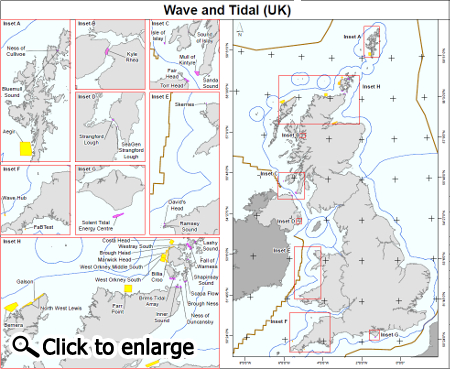
Tidal Energy
The use of devices which harness tidal energy to make electricity is becoming increasingly popular in the UK. The RYA explains how these devices work and how they can affect recreational boating.
Marine renewable energy covers a range of technologies including wave, tidal and ocean thermal energy conversion. Unlike the three-bladed turbines used to capture wind energy, there is a large range of technologies used to harness tidal energy. The process by which the most popular technologies work can be seen below, but in practice, they could look very different both in size and shape.
There are a number of tidal energy sites already leased within UK waters. The Crown Estate website lists information about each project, including test sites, and where each site is in the planning process. You can also click on the image below for a larger view of The Crown Estate map.

This map is courtesy of The Crown Estate.
Whilst the RYA acknowledges the Government's desire to promote renewable energy, it is keen to ensure that the navigational safety of recreational craft is safeguarded around the coast.
The RYA has developed a detailed position statement on offshore renewable tidal energy developments, based on recreational craft data, which it provides to every developer during the consultation process. The RYA believes that the impact that tidal energy installations have on recreational boating can be minimised provided developers fully consider the following key points:
- Collision risk. The RYA believes that the collision threat to recreational yachts can be minimised by specifying:
- A minimum underwater clearance of 4 metres below chart datum for submerged tidal energy converters, assuming flat water conditions. However, given the nature of these devices and the high tidal energy environments that they will be located in, the RYA proposes that an underwater clearance of 8 metres below chart datum would give an appropriate safety margin for submerged devices.
- Appropriate location, charting and marking of devices.
- Zoning of navigation in areas in close proximity to barrages and lagoons.
- Marking and Lighting. The RYA supports the guidance provided by the General Lighthouse Authorities and works with them to identify site specific issues that may occur.
- Navigational and communication equipment. Any proposed development should account for the effect on small craft navigation and communication equipment in detail.
- Location. Recreational routes, general sailing and racing areas must be accounted for when examining the impacts of offshore tidal energy developments. Barrages and lagoons should have convenient small craft locks created to facilitate safe transit.
- Sailing and racing areas. A tidal array, barrage impoundment or lagoon that encroached into a racing or sailing area would increase the risk of accidents occurring and could discourage visitors, therefore having the potential to have an adverse effect not only on the visitors but also on the local economy.
The RYA has also carried out an extensive mapping project to identify the main cruising routes, sailing and racing areas to better inform the management process. Initially this culminated in a detailed description of cruising routes, racing and sailing areas for the three strategic wind farm development areas in 2004 and is reported in the document 'Sharing the Wind'.
This project then evolved to cover the whole of the UK following considerable demand from the offshore renewable energy industry. In 2005, with funding from Trinity House, the RYA produced the first UK Coastal Atlas of Recreational Boating. This dataset has since been updated and is now regularly incorporated into developers’ consultations and navigational risk assessments.
If you have any questions or comments please email us at: offshore.renewables@rya.org.uk
Photo at top of page: "Marine Current Turbines" which harness tidal energy, courtesy of Siemens.
Contact UsArticle Published: July 04, 2013 12:05
Article Updated: July 08, 2014 11:04
Elsewhere on the web
Information from The Crown Estate on how the seabed is leased for wave and tidal energy in the UK.
The Crown Estate's portfolio of wave and tidal energy sites in the UK.
The Crown Estate has a host of maps showing the locations of offshore renewable energy developments in the UK.